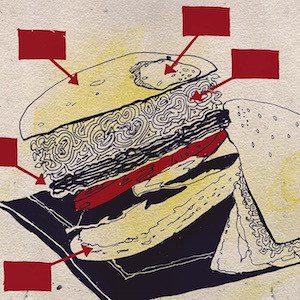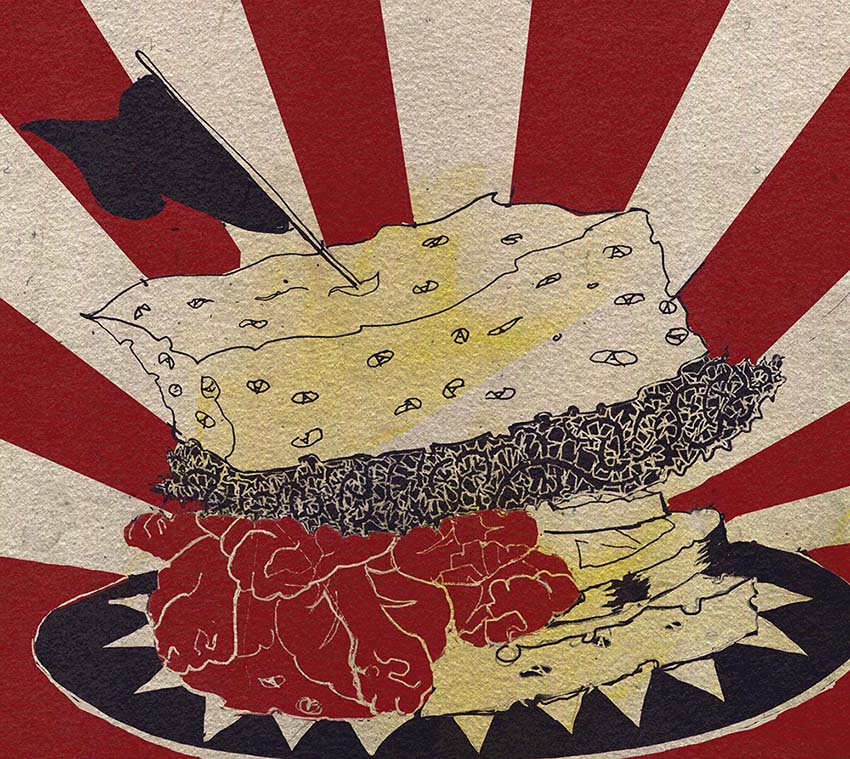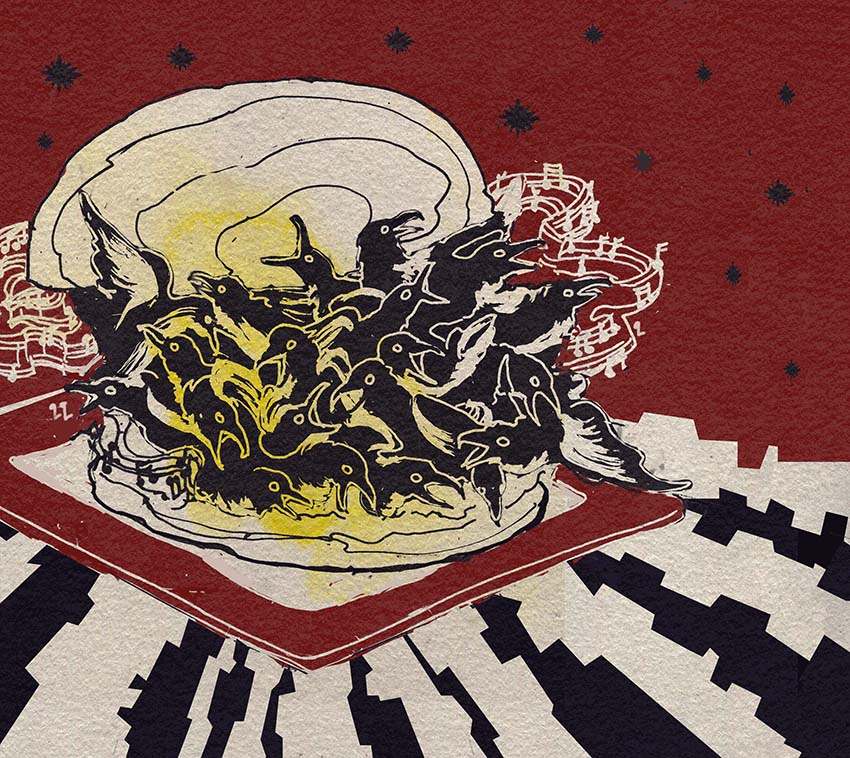
To consume the flesh, blood and bones of any creature is to celebrate death. This planet is living and provides life. “‘Take these green herbs for your meat’. Life comes from life, and death comes from death.”
–Introduction to The How to Overthrow Any Government Without Violence Cookbook: A Vegan Cookbook (1989)
In the epilogue to this anarchist’s guide to cooking vegan fare, the authors make references to the NRA, the meat lobby, AIDS, TV evangelists, Avon and rocket inventor Werner Von Braun. Statements like this are not uncommon: “Nowhere are people being warned that maybe it is a pork chop and not a penis or hypodermic needle which kills. There is nowhere recorded an AIDS victim who was and is vegan.”
Among recipes for Tempeh Sandwich a la King and Crunchy Tofu Chunks, “Life comes from life, and death comes from death.”
I was thinking about death—not my own personal grapplings with it, necessarily, but the idea of it—when I found this book at a friend’s house. It seemed fortuitous to receive this gift of vegan dogma in thinking about how we engage with death in our daily lives, record it, remember it, ignore it. If you, like me, enjoy picking apart the bizarre minutiae of human existence, then let’s consider their hypothesis.
Life comes from life. A baby is born to a mother—both needy, breathing, beings. An aloe plant can be propagated by separating the aloe pup, which shares a root system with the mother plant, and planting the new offshoot. Life lends to life, sure.
Death comes from death. On the literal level, when someone dies, another person doesn’t necessarily die with them. Of course, when you die, someone else is probably dying at the same time, in a shopping mall in Albuquerque, maybe. But one death doesn’t directly cause another (freak circumstances notwithstanding) and on a figurative level, it’s not quite apt either. And in a Christian or Hindu framework, death doesn’t bring death; it can bring something better. Heaven. Reincarnation. Rebirth.
Lately I’ve been listening to the great gospel musician Washington Phillips. In the 1928 tune “What Are They Doing in Heaven Today?” Phillips sings, “I’m thinking of friends that I used to know/Who lived and suffered in this world below/But they’re gone off to heaven, but I want to know/What are they doing there now?”
Phillips was an outlier in the guitar evangelist movement. In the early twentieth century, there were a good number of them, many of whom were blind. With few other avenues for earning money, these blind men and women could make a living playing music on the street corner. But unlike the others, Phillips—who was not blind—created his own instrument, a fusion of two zithers or dulcimers (it’s up for debate) that produced a quiet, peaceful sound. The guitar evangelist sound was country blues. The Phillips sound was ethereal, floating, heavenly.
https://youtu.be/or1oZ35NA2U&w=580
Like others in the black sacred music tradition, Phillips preached that even though this life isn’t so great, there’s a better world ahead. His musical gospel espoused the Christian idea of heaven, of a promise of life after death, a better life after death. While contemporary gospel music tends to suggest that things can be better here, in this life, the spirituals didn’t hold out such hope. The Blues modus operandi is to present a problem and a solution—typically not a socially acceptable one: “I’m gonna get my gun and shoot my wife, » for instance. Or the Blues artists will tell you there’s never going to be a solution; you just stay blue. (“One thing they don’t tell you ’bout the blues when you got ’em, you keep on fallin’ ’cause there ain’t no bottom,” sings Emmylou Harris, whose blues Maggie Nelson highlights in Bluets.) The spirituals, and Phillips, fit right in the middle, then, preaching that hope lies in another existence. From death comes life.
As a culture, we tend to place more significance on the mystique of death than the actual event. We avoid considering the details: the transportation of the body down to the morgue, the excising of the organs, the decay of the skin within the tomb. Like a wedding or a birthday party, we place more emphasis on the fanfare, the pomp and circumstance, than the underlying gravity of the event. Maybe it’s too much to consider.
Americans don’t handle death very well. We detest aging, slathering creams and oils on our skin to prevent any sign of our nearness to the End. Unless you live in New Orleans, as I do, your notion of a funeral is most likely a black-suited exercise in solemnity and abject sorrow. A fit of laughter feels like an offense.
Instead of avoiding these conversations about death, why don’t we do more to engage in them?
We could go about it in a number of ways. Via intellectual inquiry, perhaps. (Cicero said “to study philosophy is nothing but to prepare one’s self to die.”) Or by chasing la petit mort. Before settling you into savasana, or corpse pose, a yoga teacher may urge you to “practice death,” to try and detach yourself from your most precious earthly belonging: your body. Pattabhi Jois, who developed the Ashtanga form of yoga, said that with savasana you get to experience “a small death, every moment, every day.”
If we make death a part of our daily conversations, we can appreciate our lives more. We can appreciate our deaths. When we anticipate the end we can feel energized, motivated, by its inevitability.
***
Rumpus original art by Kara Y. Frame.
***
Want more R.I.P.? Visit the archives here.






